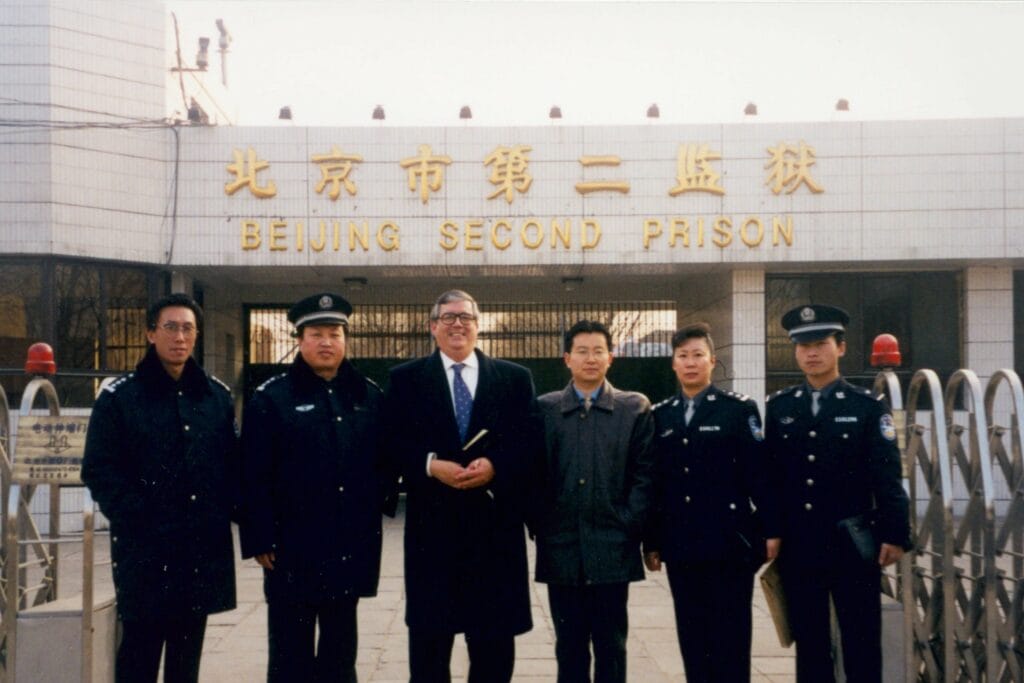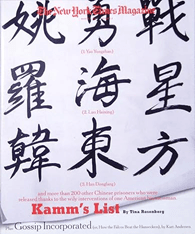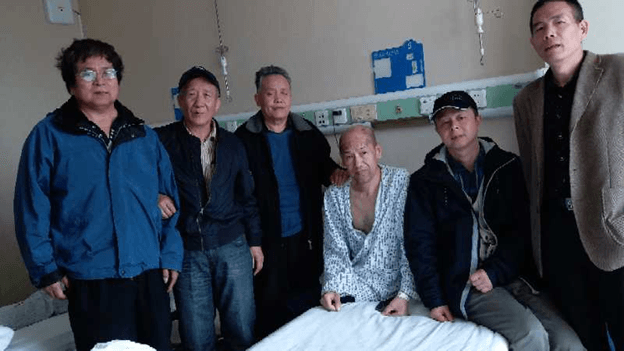John recounts an unsettling visit to Beijing Number Two Prison in 2001 and learns that even in a hopeless and oppressive environment, opportunities often surface.
<< Read all John Kamm Remembers stories

In August 2001, I was contacted by a New York Times journalist, Tina Rosenberg, to ascertain if I was willing to be featured in an article examining the nexus between business and human rights. Among the companies to be featured were an oil company operating in Africa and a sporting goods company sourcing products from an Asian country.

Not long afterward, and following a trip to Washington, Ms. Rosenberg informed me that her editor had decided to focus on my work to the exclusion of others. The article would eventually be published in the New York Times Magazine March 2002 issue as “John Kamm’s Third Way,” but, because it was a cover story, it would also be titled “Kamm’s List” on the cover.
Reflecting China’s desire to improve its relationship with the United States in the aftermath of the September 11, 2001, attacks on New York and Washington, the Chinese government agreed to let Ms. Rosenberg and a photographer, Zeng Nian, enter the country to observe me in action.
I arrived in Beijing a day before The New York Times team to finalize arrangements. It was an aggressive schedule. Meetings were arranged with Chinese officials from the Ministry of Foreign Affairs and the Supreme People’s Court, the US Embassy, including Ambassador Clark Randt, foreign diplomats, and American business leaders. We spent a day traveling around the city photographing locations that I frequented – the Beijing Train Station, the Procuratorate bookstore, and shopping districts. I asked whether the New York Times team could accompany me on a visit to a prison, but the Ministry of Justice flatly denied this request, claiming that my visits to prisons were “personal” matters between me and the ministry.
Visit to a Maximum Security Prion in Beijing
And so, on December 18, 2001, I visited Beijing Municipality Number Two Prison, accompanied by officials of the Ministry of Justice and the Beijing Municipality Prison Administration Bureau. The visit lasted approximately two hours.
Beijing Number Two Prison is a maximum-security facility housing, in 2001, approximately 2000 male prisoners. It is located just off the Beijing-Shenyang Expressway in east Beijing (now part of Beijing-Harbin Expressway). A large percentage of the prisoners have committed violent crimes. It was designated a maximum-security prison—one in which most of the prisoners serve sentences of at least 15 years in length in 1990. For 40 years before 1990, Beijing Number Two Prison was an agricultural prison brigade housing prisoners with light sentences.
Beijing Number Two Prison was, and still is, a maximum-security facility. Unlike other prisons I had visited in China, including Tianjin Prison earlier in 2001, Beijing Number Two Prison has not been designated a model prison by the Ministry of Justice. Its facilities, including its clinic, are less extensive and more poorly equipped, and the cellblocks are more crowded and less well-appointed than those of model prisons. Its 18 wards are housed in six three-storied cell blocks. The tour revealed a physical plant badly in need of repair and better maintenance. Foreigners were rarely taken to the prison; I was the only foreign visitor to have visited in the previous 12 months.
Prisoners are under strict control at the facililty. No contact of any kind was permitted between me and the prison population. The wardens stated that there had been no escapes, riots, or suspicious deaths in the prison since 1995.
The Prisoner Distribution Center of the Beijing Prison Administration decides where to incarcerate people sentenced to prison by Beijing courts. I knew that, although Beijing Number Two is designated a facility for housing violent offenders with long sentences (including several sentenced to life imprisonment), many of the prisoners convicted of counterrevolution and endangering state security by Beijing courts — including several with sentences ranging from four to eight years — were sent there.
Prisoners who have served their sentences at Beijing Number Two Prison include Xu Wenli (徐文立), Zha Jianguo (查建国), and numerous practitioners of unorthodox religions. More recently, American religious prisoner Pastor David Lin (林大卫) spent most of the time in carceral facilities in Beijing Number Two Prison. He encountered prisoners from 39 countries of whom around were 15 American citizens.

Of the 40 Beijing prisoners on Dui Hua’s list of “important prisoners” in 2001, 26 were believed to be incarcerated in Beijing Number Two Prison. The wardens admitted that there was a “small number” of prisoners with light sentences — including those convicted of counterrevolution and endangering state security—in Beijing Number Two. I asked questions about several of them, but the wardens were not in a position to provide information.
Liu Jingsheng
One of the prisoners I wanted to find information about was Liu Jingsheng (刘京生), a labor leader from the Democracy Wall period who co-edited an underground magazine, Tansuo 探索, with Wei Jingsheng. He was detained in May 1992 and subsequently sentenced to 15 years in prison. Since the wardens would not provide information about prisoners, I tried a tactic to at least bring up Liu’s name. As we were walking by the prison basketball court, I remarked that Liu Jingsheng was a good basketball player. If a foreigner mentions a Chinese prisoner to a prison official, the official must inform senior levels.
Dui Hua put Liu’s name on 17 lists submitted to the Chinese government and received 16 responses. After several sentence reductions, Liu was released in November 2004. He remained active for a few years – accepting an award from Wei Jingsheng, giving interviews, contributing articles to pro–democracy websites. He visited June 4 prisoner Zhang Yansheng in April 2019. Nothing has been heard of him and his work since the visit.

I asked whether or not the prison had considered adopting the fen lei gai zao (分类改造) system being used in Tilanqiao. In this system, prisoners convicted of a certain crime are housed together and kept apart from prisoners convicted of other crimes. The wardens replied that Beijing Number Two Prison was in fact practicing a kind of fen lei gai zao: prisoners are grouped into four broad categories – 1) violent criminals, 2) sexual offenders, 3) those convicted of economic crimes and 4) others. Those convicted of counterrevolution and endangering state security are considered category 4 prisoners.
A detailed account of the point system used to reward prisoners with sentence reductions, good behavior parole and other benefits (e.g., more frequent family visits, conjugal visits, use of two outside telephone lines to receive calls from family members) was given. Points are assigned according to how well a prisoner performs with respect to following regulations, “accepting re-education,” and performing physical labor. The prisoners make handicraft items and undertake unspecified “value adding” work for light industrial products. The wardens claimed that the prison’s combined rate of sentence reduction and parole exceeded 25 percent per year; that is, more than one in four prisoners receive either a reduction or parole every year.
No Way Out
The warden did not know the sentence reduction or parole rate for counterrevolutionaries and those convicted of endangering state security. I brought up an October 1997 Notice issued by the Supreme People’s Court that states “Sentence reduction and parole for prisoners convicted of seriously endangering state security…should be strictly controlled.” In practice, what does this mean? Do such prisoners receive parole and sentence reductions at a rate less than the rate of the prisoner population as a whole? The wardens did not deny that prisoners convicted of political offenses benefit from fewer paroles and sentence reductions but maintained that there was no discrimination among prisoners in the point system itself. “Strict control” is exercised by the courts, which examine and rule on applications for sentence reduction and parole (but not medical parole, which is decided by prison authorities).
To better understand how the parole and sentence reduction system works, I asked if a prisoner like Han Chunsheng (韩春生) – an avid listener of VOA broadcasts who had always maintained his innocence and refused to acknowledge guilt – can ever qualify for parole or sentence reduction. The warden replied that prisoners who continue to maintain their innocence can file petitions with the courts for release and/or retrial.
And if those petitions are rejected?
“Then the prisoner has no way out.”
Listen to the Encounters with China podcast.
Subscribe to receive notifications about new episodes.
Read all John Kamm Remembers stories.
